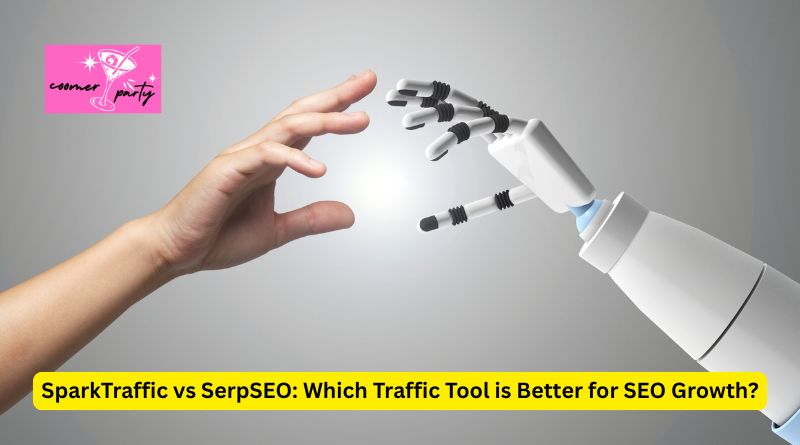In the digital marketing world, web traffic is the fuel that drives online success. For websites trying to boost visibility, enhance user engagement, and climb the ranks on Google, traffic generation tools can offer an edge. Two popular names that often come up in this conversation are SparkTraffic vs SerpSEO. Both platforms promise to increase website visits, improve SEO rankings, and help digital marketers outperform their competition. But how do they truly compare? Which one provides better value and results? In this article, we’ll explore the features, advantages, and downsides of SparkTraffic and SerpSEO to help you make an informed decision.
What is SparkTraffic?
SparkTraffic is an automated traffic generation tool designed to simulate real human visits to your website. It uses a global network of proxies and bots to send organic-looking traffic to your site. One of SparkTraffic’s biggest appeals is its simplicity—it offers users an easy way to boost page views without complex setups. The platform allows for traffic customization based on geolocation, bounce rate, average session time, and even device type. This makes it a good option for those who want to manipulate traffic data for better-looking analytics.
However, SparkTraffic’s traffic is not always SEO-friendly. Since it relies heavily on bot traffic, Google Analytics can sometimes detect and filter out such visits, limiting its SEO benefit. Although it’s useful for testing websites under load or increasing ad impressions, it might not provide the genuine user engagement that real traffic tools aim to deliver.
What is SerpSEO?
SerpSEO, on the other hand, positions itself as a more SEO-oriented traffic solution. While it also allows traffic simulations, its primary focus is helping websites improve their SERP (Search Engine Results Page) rankings through behavioral metrics. SerpSEO provides features such as keyword-based visits, time-on-page customization, CTR (Click Through Rate) improvement, and real-user session emulation.
The main strength of SerpSEO lies in its strategic approach. Rather than just flooding a site with fake traffic, it mimics natural browsing behavior, increasing the likelihood that Google sees these visits as authentic. This can positively impact bounce rates, dwell time, and ultimately rankings. Compared to SparkTraffic, SerpSEO offers a more nuanced and SEO-aligned traffic solution.
SparkTraffic vs SerpSEO: Key Differences
When comparing SparkTraffic vs SerpSEO, it’s essential to consider what your goals are. If your objective is to artificially inflate traffic numbers for analytics or ad impressions, SparkTraffic might be the better fit. It’s budget-friendly and easy to use. But if your main aim is to enhance SEO rankings using behavioral signals and keyword targeting, SerpSEO emerges as a more strategic tool.
One major difference lies in how each platform approaches user simulation. SparkTraffic often uses bot-based traffic, which may not be effective for long-term SEO results. In contrast, SerpSEO’s human-like behavior emulation can offer more sustainable SEO improvements. While SerpSEO may be slightly more expensive, the return on investment can be higher if SEO performance is your top priority.
Pros and Cons: SparkTraffic vs SerpSEO
SparkTraffic Pros:
Affordable pricing for high traffic volume
Easy to set up and start using
Useful for testing website performance
SparkTraffic Cons:
Mostly bot traffic with limited SEO value
Risk of being flagged by analytics tools
Limited control over user behavior
SerpSEO Pros:
Realistic traffic simulation for SEO
CTR and dwell-time optimization
Keyword-targeted visits for ranking improvement
SerpSEO Cons:
Higher cost compared to SparkTraffic
May require a learning curve for best results
Which Tool Should You Choose?
The choice between sparktraffic vs serpseo ultimately depends on your goals and expectations. If you’re running a new website and simply need traffic volume to test your layout, server load, or to impress clients with high numbers, SparkTraffic can be a quick solution. However, for long-term SEO growth, ranking improvements, and a strategy aligned with Google’s behavioral metrics, SerpSEO offers more benefits.
Keep in mind that Google’s algorithms are increasingly smart at identifying low-quality traffic. Tools that focus on real user engagement are more likely to yield lasting results. So, if SEO is your main objective, SerpSEO is worth the investment.
Final Verdict: SparkTraffic vs SerpSEO
In conclusion, SparkTraffic vs SerpSEO is a comparison of quantity versus quality. While SparkTraffic offers a simple and cost-effective way to boost numbers, SerpSEO provides more meaningful results by focusing on user behavior and search engine ranking factors. Choose wisely based on your project goals, but for serious SEO efforts, SerpSEO is likely the better long-term ally.

